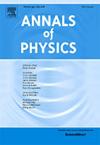Physics-informed renormalisation group flows
IF 3
3区 物理与天体物理
Q2 PHYSICS, MULTIDISCIPLINARY
引用次数: 0
Abstract
Strongly correlated systems offer some of the most intriguing physics challenges such as competing orders or the emergence of dynamical composite degrees of freedom. Often, the resolution of these physics challenges is computationally hard, but can be simplified enormously by a formulation in terms of the dynamical degrees of freedom and within an expansion about the physical ground state. Such a formulation reduces or minimises the computational challenges and facilitates the access to the physics mechanisms at play. The tasks of finding the dynamical degrees of freedom and the physical ground state can be systematically addressed within the functional renormalisation group approach with generalised field transformations.
The present work uses this approach to set up physics-informed renormalisation group flows (PIRG flows): Scale-dependent coordinate transformations in field space induce emergent composites, and the respective flows for the effective action generate a large set of target actions, formulated in emergent composite fields. This novel perspective bears a great potential both for conceptual as well as computational applications: PIRG flows allow for a systematic search of dynamical degrees of freedom and the respective ground state that leads to the most rapid convergence of expansion schemes, thus minimising the computational effort. Secondly, the resolution of the remaining computational tasks within a given expansion scheme can be further reduced by optimising the physics content within a given approximation. Thirdly, the maximal variability of PIRG flows can be used to reduce the analytic and numerical effort of solving the flows within a given approximation.
物理信息重整群流
强相关系统提供了一些最有趣的物理挑战,如竞争顺序或动态复合自由度的出现。通常,这些物理挑战的解决在计算上是困难的,但可以通过一个基于动态自由度的公式和关于物理基态的扩展来极大地简化。这样的公式减少或最小化了计算挑战,并促进了对物理机制的访问。寻找动力学自由度和物理基态的任务可以用广义场变换的功能重整化群方法系统地解决。目前的工作使用这种方法来建立物理信息重整化群流(PIRG流):场空间中依赖于尺度的坐标变换诱导出紧急复合,而有效动作的各自流产生了大量的目标动作,在紧急复合场中形成。这种新颖的视角在概念和计算应用方面都具有巨大的潜力:PIRG流允许系统地搜索动态自由度和各自的基态,从而导致扩展方案的最快速收敛,从而最大限度地减少计算工作量。其次,通过优化给定近似内的物理内容,可以进一步降低给定展开方案内剩余计算任务的分辨率。第三,利用pig流动的最大变异性可以减少在给定近似范围内求解流动的解析和数值努力。
本文章由计算机程序翻译,如有差异,请以英文原文为准。
求助全文
约1分钟内获得全文
求助全文
来源期刊

Annals of Physics
物理-物理:综合
CiteScore
5.30
自引率
3.30%
发文量
211
审稿时长
47 days
期刊介绍:
Annals of Physics presents original work in all areas of basic theoretic physics research. Ideas are developed and fully explored, and thorough treatment is given to first principles and ultimate applications. Annals of Physics emphasizes clarity and intelligibility in the articles it publishes, thus making them as accessible as possible. Readers familiar with recent developments in the field are provided with sufficient detail and background to follow the arguments and understand their significance.
The Editors of the journal cover all fields of theoretical physics. Articles published in the journal are typically longer than 20 pages.
 求助内容:
求助内容: 应助结果提醒方式:
应助结果提醒方式:


